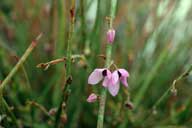In Flower This Week
A weekly news sheet prepared by a Gardens' volunteer.
Numbers before each plant refer to temporary IFTW labels in the gardens.
Numbers in square brackets [ ] refer to garden bed Sections. Plants in flower are in bold type.
View past issues of 'In Flower This Week'.
13 September 2013
Tetratheca subaphylla click for larger image |
The ‘Cool Temperate Orchid Display’ is a MUST for those who are passionate about those flowers and even for those who are not passionate. In either case, spring is definitely here...
- Thryptomene saxicola [Section 172] are small shrubs covering the rise to the Visitor Information Centre (VIC). They are clad with tiny pink flowers.
- Hardenbergia violacea [Section 172] is an entanglement of vines displaying deep purple pea-shaped flowers, seen beside the stairs to the VIC and in many other locations in the gardens.
- The potted plants outside the VIC include Gastrolobium parvifolium with orange-red pea-shaped flowers, Tetratheca subaphylla with mauve flowers, the vivid blue flowers of Dampiera latealata, the mass of gorgeous pink daisy flowers of Rhodanthe chlorocephala, and the startling cream Rock Orchids, Dendrobium speciosum, a remarkable sight.
- Edging Banks Walk a selection of flowers persists among a variety of green foliage, including Philotheca myoporoides subsp. acuta [Section 174], a medium spreading shrub with white-petalled flowers.
- Opposite is one of the many colourful wattles in the gardens. It is the Snowy River Wattle, Acacia boormanii [Section 210], a large shrub clad with its soft yellow flower balls.
- Another flower easily seen is a cultivar of the Lilac Hibiscus, Alyogyne huegelii ‘West Coast Gem’ [Section 210]. It is an upright shrub with large purple flowers.
- Falling over the rocks, Prostanthera phylicifolia [Section 210] is clad with small mauve flowers.
- Across the road and crowded among other shrubs, Grevillea ‘Scarlet Sprite’ [Section 174] has red spider shaped flowers.
- The area of white daisies are those of Rhodanthe anthemoides [Section 174] while
- In a pot Chorizema cordatum [Section 174] bears its colourful red-orange pea-shaped flowers on extended stems over the edge of the pot.
- A cultivar of Geraldton Wax, Chamelaucium ‘Cascade Jewel’ [Section 174], displays its mottled pink-petalled flowers over a medium size shrub.
- Rounding the corner Grevillea ‘LadyO’ [Section 174] is a low open shrub forever displaying its many red spider flowers.
- The large Grass Tree, Xanthorrhoea glauca [Section 60] has a dense grass skirt and three dark spear-like immature flower spikes.
- Follow the road on the far side of the Rainforest where Rock Orchids [Section 125] are attached to rocks edging the road. Many have immature green flower spikes.
- Opposite, Grevillea rosmarinifolia ‘Rosy Posy’ [Section 128] is a small open shrub attractive with dangling pink-cream flowers.
- Grevillea ‘Goldfever’ [Section 124] is a low dense shrub with lateral branches clad with apricot-coloured flowers.
- Reaching the Main Path, take a glance up high among the Rainforest trees to view a tree densely covered with dark green leaves and with sprays of small white flowers. It is Acradenia euodiiformis [Section 158].
- Close by is a Walking Stick Palm, Linospadix monostachyos [Section 145] small and slender with a leafy top and with long fine arching strands of buds followed by red fruits.
- Return to take the Main Path to the Rock Garden. Edging the path are several Wollemi Pines, Wollemia nobilis [Section 78, 110]. They are upright small trees clad with narrow pointed leaves and crowned now with both male and female cones.
To arrive at the Shade House Orchid Display the map is well marked.
Barbara Daly
![Director of National Parks [logo]](../../../../images/dnp_90px.gif)







